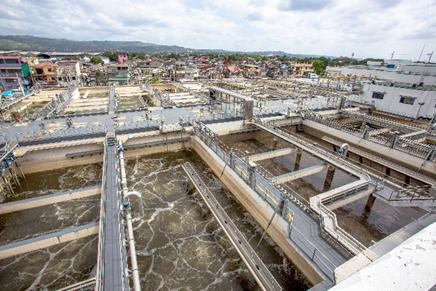Manila Water to construct more wastewater facilities to help curb pollution

Manila Water targets to have a total of 53 wastewater facilities with 1,156 MLD treatment capacity which will cover 100% of its concession area, which translates to a total of 715 kilometers of sewer network to serve 7.6 million population in the East Zone. Photo shows the sequence batch reactor (SBR) beds at the Marikina North Sewage Treatment Plant in Barangay Nangka, Marikina City.
East Zone concessionaire Manila Water is reinforcing its commitment to the Philippine Clean Water Act as the company operates more wastewater treatment plants to ensure that domestic wastewater from households does not contribute to the pollution of rivers and other water bodies.
“As Manila Water is committed to provide 24/7 clean and potable water to our customers, we are also focused on protecting the environment by making sure that we properly dispose, treat wastewater and its by-products, as these remain essential elements of our services,” said Manila Water Wastewater Operations Head Donna Perez.
Manila Water’s wastewater treatment plants employ various technologies to treat wastes and pollution through a variety of mechanisms and processes. Its wastewater management includes the collection of sewage and septage from households and establishments, and the conveyance, full treatment, and safe disposal of by-products.
The company has also expanded its wastewater services to cover more areas and benefit more people in the East Zone. From a single sewage treatment plant (STP) in 1997, Manila Water now operates 41 treatment facilities, increasing the company’s wastewater treatment capacity by 925%, from 40 million liters per day (MLD) at the start of operations to 410 MLD at present.
The water company is also set to build 12 additional STPs as it continues to fulfill its mandate of providing sewerage and sanitation services to help improve the water environment in the metropolis and thereby safeguard public health.
Manila Water targets to have a total of 53 wastewater facilities with 1,156 MLD treatment capacity that will cover 100% of its concession area, which translates to a total of 715 kilometers of sewer network to serve 7.6 million population in the East Zone.
In recent years, Manila Water undertook a major project to ensure compliance with Administrative Order (DAO) 2016-08 of the Department of Environment and Natural Resources that included new parameters in biological nutrient removal (BNR) of Nitrogen and Phosphorus.
This entailed the diversion of flows from 11 smaller treatment plants to larger facilities and enhanced activated sludge process to 27 others. Last year, the DAO was amended to DAO 2021-19, updating General Effluent Standards for six parameters, including Ammonia and Phosphorus. By June 2021, all of Manila Water’s 41 STPs have complied with this amended order, which translates to the removal of 4,708 tons of nutrients per year.
READ: Manila Water reaches 25 years, renews commitment to quality water, environmental services